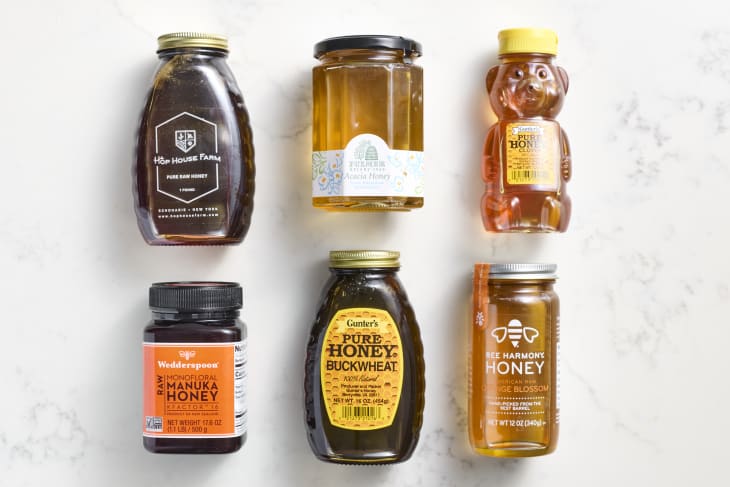6 Popular Types of Honey You Should Know
A good jar of honey is a pantry hero. It’s a natural sweetener with an indefinite shelf life. In addition to its classic role in a strong cup of tea, honey is a great addition to marinades and glazes (like this honey garlic salmon) as well as baked goods like honey cake and honey spice cookies. Add some hot peppers and you’ve got hot honey; add it to butter and you’ve got the perfect spread for buttermilk biscuits. Its uses are near endless.
The world of honey, however, can be difficult to navigate. Honey comes in many different varieties, and it can be unclear what the differences are between one type of honey and another. We’re here to break down the differences between six common types of honey and what they’re best used for.
How Do Bees Produce Honey?
Honeybees collect nectar from flowers, which they store in a specialized stomach called a “honey sac.” Enzymes in the honey sac break down the nectar. When the bees get back to the hive, they pass this nectar to worker bees who add their own enzymes, and then place it in the cells of the honeycomb. The worker bees use their wings to drive moisture from the nectar before sealing each full cell with beeswax.
Clover Honey
This light-colored honey is made from the nectar of clover flowers. It’s one of the most popular honey varieties and can be found on many grocery store shelves. Its mild, floral, sweet flavor lends itself well to many applications in the kitchen, making it a good pantry staple. It works just as well in a cup of tea as it does sweetening a marinade.
Best for: Baking, salad dressings, sauces, glazes, tea
Orange Blossom Honey
Another very popular honey variety, orange blossom honey is a favorite due to its mildly citrusy flavor. Similar to clover honey, it is typically quite light in color and pretty easy to find, but be sure to check the ingredient label. Some companies add artificial orange flavoring to their bottles.
Best for: Baking, tea, salad dressings, sauces, sweetening cocktails
Wildflower Honey
Wildflower honey can come from the nectar of many different kinds of flowers. This variety of honey can take on a spectrum of floral flavors as a result and ranges in color from light to dark. This a great option for “stepping up your honey game” so to speak if you’re looking for something with a little bit more of a distinct flavor than milder varieties like clover honey.
Best for: Drizzling, charcuterie boards
Acacia Honey
Contrary to its name, acacia honey is not harvested from the acacia flower, instead coming from the flowers of the black locust tree. One of the lightest colored honeys, this variety has a very mild flavor and is a great choice for an “all-purpose” honey. If you don’t use honey too often, this one is for you. Its high fructose content means it doesn’t crystallize as easily as other varieties.
Best for: Tea, baked goods
Buckwheat Honey
Buckwheat honey has one of the darkest colors of any honey you can find. It has a bolder flavor than more lighter colored varieties, sometimes described as both nutty and slightly bitter. Its strong flavor stands up well to mixing in with other flavors in a dish, making it a great choice for cooking and baking applications.
Best for: Baked goods, marinades, and glazes
Manuka Honey
Manuka honey comes from the flowers of the manuka tree that only grows in the North Island of New Zealand. It is harvested exclusively during a two- to six-week period of summer and must go through a certification process to be recognized as true Manuka honey. It can range in color from dark to creamy brown and has a thick, spoonable consistency.
According to the National Library of Medicine, “Manuka honey has been found to have various biological activities, including antioxidant, antimicrobial and anti-proliferative capacities.” Its rarity and health benefits combine to make it one of the most expensive honey varieties. We recommend consuming it in raw applications and saving your less-pricey honeys for cooking and baking.
Best for: Consuming raw, drizzled on toast or yogurt
